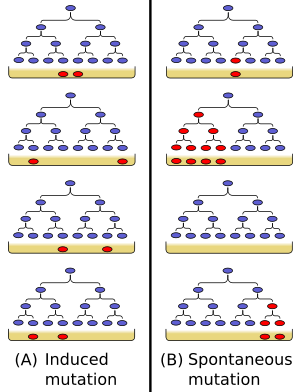- Luria–Delbrück experiment
-
 The two possibilities tested by the Luria–Delbrück experiment. (A) If mutations are induced by the media, roughly the same number of mutants are expected to appear on each plate. (B) If mutations arise spontaneously during cell divisions prior to plating, each plate will have a highly variable number of mutants.
The two possibilities tested by the Luria–Delbrück experiment. (A) If mutations are induced by the media, roughly the same number of mutants are expected to appear on each plate. (B) If mutations arise spontaneously during cell divisions prior to plating, each plate will have a highly variable number of mutants.
The Luria–Delbrück experiment (1943) (also called the Fluctuation Test) demonstrates that in bacteria, genetic mutations arise in the absence of selection, rather than being a response to selection. Therefore, Darwin's theory of natural selection acting on random mutations applies to bacteria as well as to more complex organisms. Max Delbrück and Salvador Luria won the 1969 Nobel Prize in Physiology or Medicine in part for this work.
In their experiment, Luria and Delbrück inoculated a small number of bacteria into separate culture tubes. After a period of growth, they plated equal volumes of these separate cultures onto agar containing phage (virus). If virus resistance in bacteria were caused by a spontaneous activation in bacteria—i.e., if resistance were not due to heritable genetic components, then each plate should contain roughly the same number of resistant colonies. This, however was not what Delbrück and Luria found. Instead, the number of resistant colonies on each plate varied drastically.
Luria and Delbrück proposed that these results could be explained by the occurrence of a constant rate of random mutations in each generation of bacteria growing in the initial culture tubes. Based on these assumptions Delbrück derived a probability distribution (now called the Luria–Delbrück distribution) that gives a relationship between moments consistent with the experimentally obtained values. The distribution that follows from the directed adaptation hypothesis (a Poisson distribution) predicted moments inconsistent with the data. Therefore, the conclusion was that mutations in bacteria, as in other organisms, are random rather than directed.[1]
The results of Luria and Delbrück were confirmed in more graphical, but less quantitative, way by Newcombe. Newcombe incubated bacteria in a Petri dish for a few hours, then replica plated it onto two new Petri dishes treated with phage. The first plate was left unspread, and the second plate was then respread, that is, bacterial cells were moved around allowing single cells in some colony to form their own new colonies. If colonies contained resistant bacterial cells before entering into contact with the phage virus, one would expect that some of these cells would form new resistant colonies on the respread dish and so to find a higher number of surviving bacteria there. When both plates were incubated for growth, there were actually as much as 50 times greater number of bacterial colonies on the respread dish. This showed that bacterial mutations to virus resistance had randomly occurred during the first incubation. Once again, the mutations occurred before selection was applied.[2]
More recently, the results of Luria and Delbrück were questioned by Cairns and others, who studied mutations in sugar metabolism as a form of environmental stress.[3] However, eventually this result was found to have been caused by selection for gene amplification and/or a higher mutation rate in cells unable to divide. Nevertheless, there is no evidence yet for directed mutagenesis: only those mutations that allow the cells to respond to the environmental stress accumulate in a growing population.[4]
References
- ^ Luria, S. E.; Delbrück, M. (1943). "Mutations of Bacteria from Virus Sensitivity to Virus Resistance". Genetics 28 (6): 491–511. http://www.genetics.org/cgi/reprint/28/6/491.
- ^ Newcombe, H. B. (1949). "Origin of Bacterial Variants". Nature 164 (4160): 150–151. doi:10.1038/164150a0.
- ^ Cairns, J.; Overbaugh, J.; Miller, S. (1988). "The Origin of Mutants". Nature 335 (6186): 142–145. doi:10.1038/335142a0. PMID 3045565.
- ^ Slechta, E. S.; Liu, J.; Andersson, D. I.; Roth, J. R. (2002). "Evidence that selected amplification of a bacterial lac frameshift allele stimulates Lac(+) reversion (adaptive mutation) with or without general hypermutability". Genetics 161 (3): 945–956. PMC 1462195. PMID 12136002. http://www.genetics.org/cgi/content/full/161/3/945.
External links
Categories:- History of biology
- Genetics experiments
- Bacteria
- Microbiology
- 1943 in science
Wikimedia Foundation. 2010.

